Use controls above or click here to open this Hometown Heroes podcast in a new window
90-year-old Robert Titus of Colorado Springs, CO appears on episode #455 of Hometown Heroes, airing January 20-22, 2017. Born in New Jersey, Titus went to high school in Norfolk, VA before enlisting in the Army during World War II. He completed paratrooper training at Fort Benning, GA but World War II ended before he could head overseas. You’ll hear him recall marching with the 82nd Airborne Division in the World War II victory parade down New York City’s Fifth Avenue. After graduating from Virginia Tech in 1948 with a degree in engineering, he joined the Air Force, quickly becoming a fighter pilot.
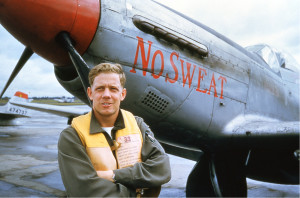
When the Korean War began, Titus was eager to get overseas and fly combat missions. After more than a year of asking to be sent to Korea, persistence paid off with his assignment to the 39th Fighter Interceptor Squadron.
“I had in my blood the image of myself as a fighter pilot,” Titus explains. “As long as there was a war and I was a fighter pilot, and what I considered to be a pretty good fighter pilot, I wanted to be involved.”
Over the next ten months, he would fly 101 combat missions, first in F-51s, then in F-86 Sabre jets, providing aerial support for ground troops with bombs, napalm, and strafing. “You’re so intent on providing the best support you can,” he says. “You just get into it, it’s like when you’re playing football, you get into the game, and you’re just one with the environment.” Titus received the first of his four Distinguished Flying Cross recognitions in March, 1952 when he used his Mustang to destroy two enemy mortar positions, two bunkers, and an ammunition dump in one mission. “There was an awful lot of ground fire,” you’ll hear Titus recall. “I got hit quite a few times.”
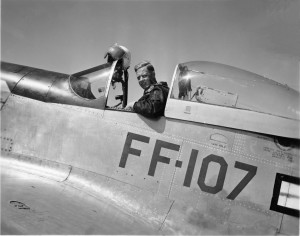
His plane was struck by anti-aircraft fire often enough that he didn’t always realize he’d been hit. Such was the case when he realized all of the Mustang’s coolant had leaked out.
“The airplane started to burn, and I was forced to bail out,” he remembers. “I just went out over the edge. I was a lot lower than I thought I was apparently, because I pulled the ripcord and the parachute opened and I hit the ground almost all at once.”
He had no idea where he was. None of the other pilots on the mission had seen him bail out, and they all believed he had been killed. “Turns out I was in the demilitarized zone,” he says. “I was between the enemy and the friendly forces.” When he saw some enemy troops headed his way, he fired a few rounds with his pistol, and heard a burp gun echo back an ominous response. “Whoa, this is not too good,” he remembers thinking. After hunkering down in a hole for a while, he was relieved to hear a “good American voice” from a Marine patrol tell him to keep his head down and crawl toward the sound of his voice. By the time he returned to his unit, he had to reclaim his possessions that had been divided up between other members of the squadron.
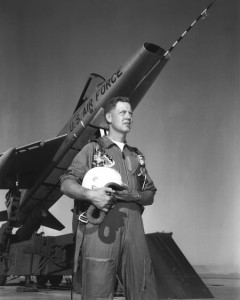
Titus says he would have liked to continue flying in Korea until the war was over, but after clearing the century mark on his mission count, he was sent back home to the U.S. Listen to Hometown Heroes to find out how he became a test pilot, and the story behind his daring 1959 trans-polar F-100 flight with his friend Charlie Blair. They became the first men to fly jets over the North Pole, and were both recognized with another Distinguished Flying Cross. Listen to Hometown Heroes for Titus’ explanation of how a ten-pilot test unit lost 15 men, and hear other details from the “Golden Age of Flight Tests,” an era the general remembers fondly. ““We learned a lot that we didn’t know anything about,” he recalls.
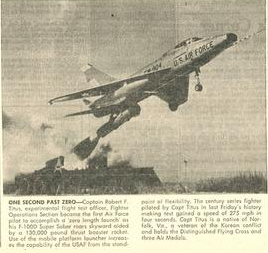
What does it take to be a test pilot? “You just have to be fortunate enough to be able to do the academics, and understand the processes,” Titus begins.
“And if you have a little skill you can stay alive.”
When the war in Vietnam developed, he again was itching to get involved. The man with the knack for doing things no one else had ever done before put the new F-5A Skoshi Tigers to the test, flying more than 300 missions from Bien Hoa Air Base. One of those missions with the 10th Fighter Commando Squadron produced his third award of the Distinguished Flying Cross, when he subjected his plane to intense ground fire as he intervened with close air support for a cornered group of American forces on the ground. In 1966, he was named commanding officer of the 389th Tactical Fighter Squadron, based in Da Nang, which led to his finally encountering the opportunity to shoot down an enemy fighter plane.
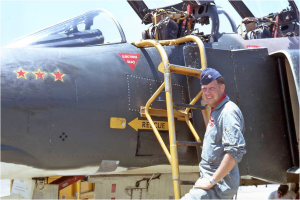
Read this article from Air Force Magazine, detailing how two F-4 Phantom II missions in the span of three days in May of 1967 saw Titus shoot down three MiG-21s, earning first the Silver Star and then the Air Force Cross.You’ll hear him describe both of those missions from his humble perspective on Hometown Heroes. While escorting a flight of F-105 Thunderchiefs on May 20, 1967, he spotted a MiG and peeled off to pursue the enemy fighter. Because of excessive radiation, his heat-seeking Sidewinder missiles wouldn’t work, so he opted for a radar-guided AIM-7 Sparrow missile instead. When the first missile he fired at the MiG didn’t guide, he tried again. ““I fired another one and it too didn’t guide,” you’ll hear Titus explain. “I thought I was going to have to ram this guy.” Instead, a third missile found its target, and Titus witnessed the enemy pilot eject the crippled plane. His Silver Star citation says his persistent pursuit demonstrated “complete disregard for his own personal safety.”
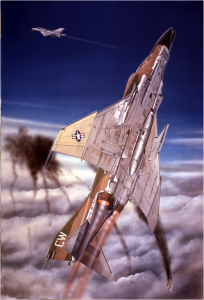
After more than 400 combat missions, he had finally fulfilled his childhood dream of an aerial victory, but two days later, his actions in the face of intense opposition would draw praise as “extraordinary heroism” and “superb airmanship” as he earned the Air Force Cross, a decoration exceeded only by the Medal of Honor. Listen to Hometown Heroes for Titus’ explanation of spotting and then eliminating two enemy fighters that went into attack mode while he was escorting another group of F-105s.
“Undaunted by accurate flak and five surface-to-air missiles that were launched at his aircraft,” the citation reads. “He repeatedly and unhesitatingly engaged numerous MiG-21s in defense of the friendly aircraft. During these aggressive and courageous aerial encounters, Colonel Titus destroyed two MiG-21 aircraft. As a direct result of his tenacity and extreme bravery in the face of great danger, the F-105 force was able to accomplish its assigned mission.”
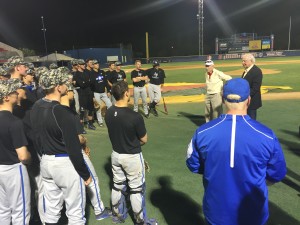
Titus downplays that description as “inflated” and shares his general feeling about combat decorations. “They decorate you for things you don’t think are particularly significant,” you’ll hear him say. “And the things that you thought were really spectacular that you accomplished, no one noticed.” Listen to the program for one example of an incident that went unrecognized by the Air Force but holds special significance in his myriad memories from a legendary aviation career. You’ll also hear about his involvement in the development of the F-15 Eagle, some of the men – including his 82nd Airborne commander, General Jim Gavin – whom Titus views as heroes, as well as the advice he shares with the countless cadets he has counseled throughout his retirement years in Colorado Springs. “Duty is the most sublime word in the English language,” Titus tells them, quoting Robert E. Lee. “No one can do more. No one should ever expect to do less.” You’ll hear him mention three-time Super Bowl champion Chad Hennings as one of the Air Force Academy football players he has sponsored, one of the many with whom he has shared those words.
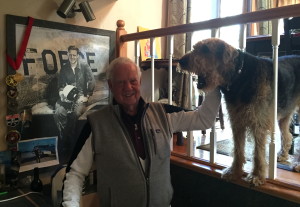
Titus continues to maintain a busy calendar, making appearances like a 2015 P-51 flight marking the 60th anniversary of the final official Air Force Mustang sortie, a mission Titus had flown as part of the Joint Parachute Test Group. On Sundays, you’ll find him juxtaposing his bass tones with his wife’s soprano in their church choir, and at the end of our conversation, you’ll hear his answer to the question of what gives him the most pride. You won’t hear him reference any of his prestigious medals, and none of the Halls of Fame or other exclusive circles to which he belong merit a mention either. Instead, he shares a simple statement reflective of his priorities.
“It’s a privilege to serve your country, and our God,” the general declares. “That’s all there is. God and family.”
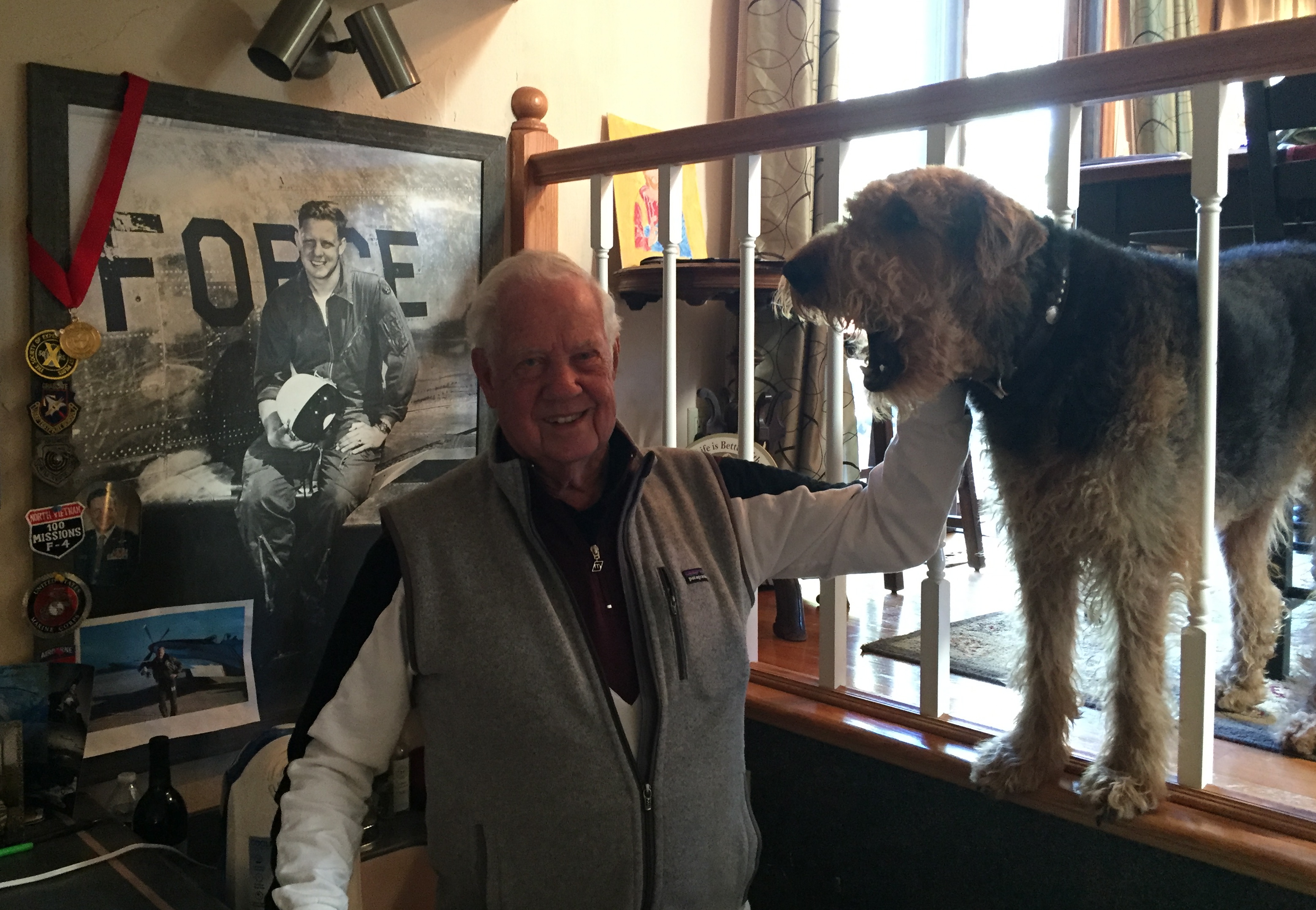


Leave a Reply